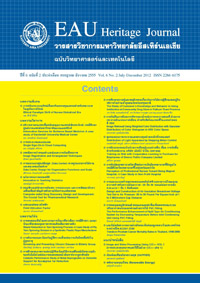Trends in Prostate Cancer Mortality Rates in Thailand, 1998-2006
คำสำคัญ:
การตาย, มะเร็งต่อมลูกหมาก, ปัจจัยเสี่ยง, mortality, prostate cancer, risk factorsบทคัดย่อ
Prostate cancer is one of the leading causes of cancer death among Thai males. It is not clear, whether or not mortality rates of prostate cancer in Thailand increased from 1998 to 2006. This study examines trends in age-specific and age-standardized mortality rates for prostate cancer among the Thai population. Mortality data during 1998-2006 were analyzed based on ICD-10 for prostate cancer. Both age-specific and age-standardized mortality rates per 100,000 were calculated and descriptively analyzed for trends.
The results shows prostate cancer mortality rates increased at least fourfold in eight years for males. The increase in mortality might be explained by the increase in risk factors including ageing of the population, higher fat diet, obesity, and hormonal factors. Health policy should increase its efforts in controlling and reducing the risk factors by promoting healthy behaviors. It is also important to educate health care providers on the profile of prostate-specific antigen testing for screening prostate cancer.
แนวโน้มอัตราการตายด้วยโรคมะเร็งต่อมลูกหมากในประเทศไทย ระหว่างปีพ.ศ.2541-2549
โรคมะเร็งต่อมลูกหมากเป็นสาเหตุการตายที่สำคัญในผู้ชายไทย ซึ่งยังไม่เป็นที่แน่ชัดว่าอัตราการตายด้วยโรคมะเร็ง ต่อมลูกหมากมีแนวโน้มเพิ่มขึ้นหรือไม่ วัตถุประสงค์ของการศึกษาเพื่อตรวจสอบแนวโน้มอัตราการตายตามกลุ่มอายุและ อัตราการตายเมื่อปรับฐานอายุของโรคมะเร็งต่อมลูกหมาก ระหว่างปี พ.ศ.2541-2549 วิธีการศึกษาโดยใช้ข้อมูลการตาย ของกระทรวงสาธารณสุข ตามบัญชีจำแนกโรคระหว่างประเทศครั้งที่10 ระหว่างปี พ.ศ.2541-2549 มาคำนวณเพื่อหา แนวโน้มอัตราการตายตามกลุ่มอายุและอัตราการตายเมื่อปรับฐานอายุต่อประชากรเพศชาย 100,000 คน
ผลการศึกษาพบว่าอัตราการตายตามกลุ่มอายุและอัตราการตายเมื่อปรับฐานอายุของโรคมะเร็งต่อมลูกหมาก มีแนวโน้มเพิ่มขึ้นอย่างน้อยเป็นสี่เท่าในช่วงระยะเวลา 8 ปี สาเหตุของการเพิ่มขึ้นน่าจะเกิดจากการเพิ่มขึ้นของประชากร ผู้สูงอายุ พฤติกรรมการบริโภคอาหารที่มีไขมันสูง ปัจจัยด้านฮอร์โมนและโรคอ้วน ดังนั้นผู้กำหนดนโยบายทางสุขภาพ ควรส่งเสริมให้ชายไทยลดปัจจัยเสี่ยงจากโรคมะเร็งต่อมลูกหมากโดยการส่งเสริมให้มีพฤติกรรมสุขภาพที่ดี รวมทั้ง การให้ความรู้แก่เจ้าหน้าที่ทางสุขภาพเพื่อตรวจคัดกรองหาโรคมะเร็งต่อมลูกหมากในระยะเริ่มต้น โดยวิธีตรวจหาระดับ พีเอสเอ แอนติเจนในเลือด







